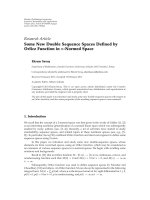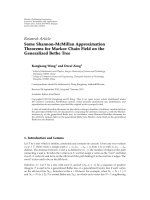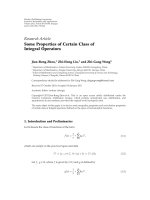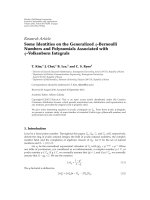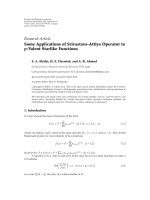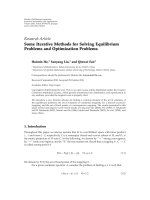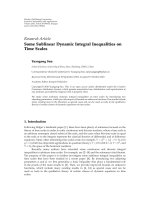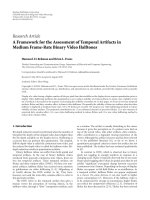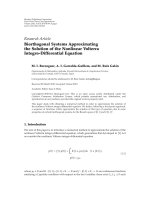Báo cáo hóa học: " Research Article Some Relationships between the Analogs of Euler Numbers and Polynomials" doc
Bạn đang xem bản rút gọn của tài liệu. Xem và tải ngay bản đầy đủ của tài liệu tại đây (812.13 KB, 22 trang )
Hindawi Publishing Corporation
Journal of Inequalities and Applications
Volume 2007, Article ID 86052, 22 pages
doi:10.1155/2007/86052
Research Article
Some Relationships between the Analogs of
Euler Numbers and Polynomials
C. S. Ryoo, T. Kim, and Lee-Chae Jang
Received 5 June 2007; Revised 28 July 2007; Accepted 26 August 2007
Recommended by Narendra K. Govil
We construct new twisted Euler polynomials and numbers. We also study the generating
functions of the twisted Euler numbers and polynomials associated with their interpola-
tion functions. Next we construct twisted Euler zeta function, twisted Hurwitz zeta func-
tion, twisted Dirichlet l-Euler numbers and twisted Euler polynomials at non-positive
integers, respectively. Furthermore, we find distribution relations of generalized twisted
Euler numbers and polynomials. By numerical experiments, we demonstrate a remark-
ably regular structure of the complex roots of the twisted q-Euler polynomials. Finally,
we give a table for the solutions of the twisted q-Euler polynomials.
Copyright © 2007 C. S. Ryoo et al. This is an open access article distributed under the
Creative Commons Attribution License, which permits unrestricted use, distribution,
and reproduction in any medium, provided the original work is properly cited.
1. Introduction and notations
Throughout this paper, we use the following notations. By
Z
p
we denote the ring of p-adic
rational integers,
Q denotes the field of rational numbers, Q
p
denotes the field of p-adic
rational numbers,
C denotes the complex numbers field, and C
p
denotes the completion
of algebraic closure of
Q
p
.Letν
p
be the normalized exponential valuation of C
p
with
|p|
p
= p
−ν
p
(p)
= p
−1
. When one talks of q-extension, q is considered in many ways such
as an indeterminate, a complex number q
∈ C,orp-adic number q ∈ C
p
.Ifq ∈ C,one
normally assumes that
|q| < 1. If q ∈ C
p
, we normally assume that |q − 1|
p
<p
−1/(p−1)
so
that q
x
= exp(xlogq), for |x|
p
≤ 1.
[x]
q
= [x : q] =
1 − q
x
1 − q
cf. [1–18]
. (1.1)
2 Journal of Inequalities and Applications
Hence, lim
q→1
[x] = x for any x with |x|
p
≤ 1inthepresentp-adic case. Let d be a fixed
integer and let p be a fixed prime number. For any positive integer N,weset
X
= lim
←−
N
Z
dp
N
Z
,
X
∗
=
0<a<dp
(a,p)=1
(a + dpZ
p
),
a + dp
N
Z
p
=
x ∈ X | x ≡ a
moddp
N
,
(1.2)
where a
∈ Z lies in 0 ≤ a<dp
N
. For any positive integer N,
μ
q
a + dp
N
Z
p
=
q
a
dp
N
q
(1.3)
is known to be a distribution on X (cf. [1–18]).
For
g
∈ UD
Z
p
=
g | g : Z
p
→ C
p
is a uniformly differentiable function
, (1.4)
the p-adic q-integral was defined by [1, 2, 6–18]
I
q
(g) =
Z
p
g(x)dμ
q
(x) = lim
N→∞
1
p
N
0≤x<p
N
g(x)q
x
. (1.5)
Note that
I
1
(g) = lim
q→1
I
q
(g) =
Z
p
g(x)dμ
1
(x) = lim
N→∞
1
p
N
0≤x<p
N
g(x) (1.6)
(see [1, 2, 6–18]). For q
∈ [0,1], certain q-deformed bosonic operators may be introduced
which generalize the undeformed bosonic ones (corresponding q
= 1); see [1, 2, 6–18].
For g
∈ UD(Z
p
)
Z
p
g(x)dμ
1
(x) =
X
g(x)dμ
1
(x) (1.7)
(see [6–18] for details).
We assume that q
∈ C with |1 − q|
p
< 1. Using definition, we note that I
1
(g
1
) = I
1
(g)+
g
(x), where g
1
(x) = g(x +1).
Let
T
p
=
m≥1
C
p
m
= lim
m→∞
C
p
m
, (1.8)
where C
p
m
={w | w
p
m
= 1} is the cyclic group of order p
m
.Forw ∈ T
p
, we denote by
φ
w
: Z
p
→ C
p
the locally constant function x −→ w
x
.Ifwetake f (x) = φ
w
(x)e
tx
,thenwe
C. S. Ryoo et al. 3
easily see that
Z
p
φ
w
(x)e
tx
dμ
1
(x) =
t
we
t
− 1
. (1.9)
Kim [8] treated the analog of Bernoulli numbers, which is called twisted Bernoulli num-
bers. We define the twisted Bernoulli polynomials B
n,w
(x)
e
xt
t
we
t
− 1
=
∞
n=0
B
n,w
(x)
t
n
n!
. (1.10)
Using Taylor series of e
tx
in the above equation, we obtain
Z
p
x
n
φ
w
(x)dμ
1
(x) = B
n,w
, (1.11)
where B
n,w
= B
n,w
(0).
The Euler numbers E
n
are usually defined by means of the following generating func-
tion:
e
Et
=
2
e
t
+1
=
∞
n=0
E
n
t
n
n!
cf. [1–18]
, (1.12)
where the symbol E
n
is interpreted to mean that E
n
must be replaced by E
n
when we
expand the one on the left. These numbers are classical and important in mathematics
and in various places like analysis, number theory. Frobenius extended such numbers as
E
n
to the so-called Frobenius-Euler numbers H
n
(u) belonging to an algebraic number u
with
|u| > 1. Let u be an algebraic number. For u ∈ C with |u| > 1, the Frobenius-Euler
numbers H
n
(u)belongingtou are defined by the generating function
e
H(u)t
=
1 − u
e
t
− u
=
∞
n=0
H
n
(u)
t
n
n!
cf. [6–10]
, (1.13)
with the usual convention of symbolically replacing H
n
by H
n
. The Euler polynomials
E
n
(x)aredefinedby
e
E(x)t
=
2
e
t
+1
e
xt
=
∞
n=0
E
n
(x)
t
n
n!
cf. [6–16]
. (1.14)
For u
∈ C with |u| > 1, the Frobenius-Euler polynomials H
n
(u,x)belongingtou are de-
fined by
e
H(u,x)t
=
1 − u
e
t
− u
e
xt
=
∞
n=0
H
n
(u,x)
t
n
n!
cf. [6–18]
. (1.15)
Kim gave a relation between B
n,w
and H
n
(u), with nth Euler numbers as follows:
B
n,w
=
n
w − 1
H
n−1
(w
−1
), if w = 1. (1.16)
4 Journal of Inequalities and Applications
Now, we consider the case q
∈ (−1,0) corresponding to q-deformed fermionic certain
and annihilation operators and the literature given therein [6–18]. The expression for the
I
q
(g) remains the same, so it is tempting to consider the limit q →−1. That is,
I
−1
(g) = lim
q→−1
I
q
(g) =
Z
p
g(x)dμ
−1
(x) = lim
N→∞
0≤x<p
N
g(x)(−1)
x
. (1.17)
Let g
1
(x) be translation with g
1
(x) = g(x + 1). Then we see that
I
−1
g
1
=−
lim
N→∞
p
N
−1
x=0
g(x)(−1)
x
+2g(0) =−I
−1
( f )+2g(0). (1.18)
Therefore, we obtain the following lemma.
Lemma 1.1. For g
∈ UD(Z
p
), one has
I
−1
g
1
+ I
−1
(g) = 2g(0). (1.19)
From (1.19), we can easily derive the following theorem.
Theorem 1.2. For g
∈ UD(Z
p
), n ∈ N, one has
I
−1
g
n
=
(−1)
n
I
−1
(g)+2
n−1
l=0
(−1)
n−1−l
g(l), (1.20)
where g
n
(x) = g(x + n).
Corollar y 1.3. For g
∈ UD(Z
p
), n(= odd) ∈ N, one has
I
−1
g
n
+ I
−1
(g) = 2
n−1
l=0
(−1)
l
g(l). (1.21)
By Lemma 1.1, we can consider twisted Euler numbers. If we take g(z)
= φ
w
(z)e
tz
,
(w
∈ T
p
), then we have
I
−1
φ
w
(z)e
tz
=
2
we
t
+1
=
∞
n=0
E
n,w
t
n
n!
. (1.22)
Now we define twisted Euler numbers E
n,w
as follows:
F
w
(t) =
2
we
t
+1
=
∞
n=0
E
n,w
t
n
n!
. (1.23)
Using Taylor series of e
zt
above, we obtain
E
n,w
=
Z
p
w
z
z
n
dμ
−1
(z). (1.24)
C. S. Ryoo et al. 5
For w
∈ T
p
, we introduce the twisted Euler polynomials E
n,w
(z). Twisted Euler poly-
nomials E
n,w
(z) are defined by means of the generating function
F
w
(t,z) =
2
we
t
+1
e
zt
= I
−1
φ
w
(x)e
t(z+x)
=
∞
n=0
E
n,w
(z)
t
n
n!
, (1.25)
where E
n,w
(0) = E
n,w
. Using Taylor series of e
tx
in the above equation, we have
E
n,w
(x) =
Z
p
φ
w
(x)(x + z)
n
dμ
−1
(x) =
n
k=0
n
k
z
n−k
Z
p
φ
w
(x)x
k
dμ
−1
(x). (1.26)
Thus we easily see that
E
n,w
(z) =
n
k=0
n
k
z
n−k
E
k,w
. (1.27)
Let χ be the Dirichlet character with conductor f (
= odd) ∈ N.Ryooetal.[16]studied
the generalized Euler numbers and polynomials. The generalized Euler numbers associ-
ated with χ, E
n,χ
, were defined by means of the generating function
F
χ
(t) =
2
f −1
a
=0
χ(a)(−1)
a
e
at
e
ft
+1
=
∞
n=0
E
n,χ
t
n
n!
. (1.28)
Generalized Euler polynomials, E
n,χ
(x), were also defined by means of the generating
function
F
χ
(t,z) =
2
f −1
a
=0
χ(a)(−1)
a
e
at
e
ft
+1
e
zt
=
∞
n=0
E
n,χ
(z)
t
n
n!
. (1.29)
Substituting g(x)
= χ(x)φ
w
(x)e
tx
into (1.21), then the generalized twisted Euler numbers
E
n,χ,w
are defined by means of the generating functions
F
χ,w
(t) =
X
φ
w
(x)e
tx
χ(x)dμ
−1
(x)
=
2
f −1
a
=0
e
ta
(−1)
a
χ(a)φ
w
(a)
φ
w
( f )e
ft
+1
=
∞
n=0
E
n,χ,w
t
n
n!
.
(1.30)
Using the above equation, E
n,χ,w
are defined by
E
n,χ,w
=
X
φ
w
(x)x
n
χ(x)dμ
−1
(x). (1.31)
Generalized twisted Euler polynomials, E
n,χ,w
(z), are defined by
F
χ,w
(t,z) = F
χ,w
(t)e
zt
=
X
φ
w
(x)e
tx
χ(x)dμ
−1
(x)e
tz
=
2
f −1
a
=0
e
ta
(−1)
a
χ(a)φ
w
(a)
φ
w
( f )e
ft
+1
e
zt
=
∞
n=0
E
n,χ,w
(z)
t
n
n!
.
(1.32)
6 Journal of Inequalities and Applications
We set
F
χ,w
(t,z) =
2
f −1
a
=0
(−1)
a
χ(a)φ
w
(a)e
(a+z)t
φ
w
( f )e
ft
+1
. (1.33)
Using the above equation, we have
∞
n=0
E
n,χ,w
(z)
t
n
n!
=
X
φ
w
(x)e
tx
χ(x)dμ
−1
(x)e
tz
=
X
φ
w
(x)e
t(x+z)
χ(x)dμ
−1
(x)
=
∞
n=0
X
φ
w
(x)(x + z)
n
χ(x)dμ
−1
(x)
t
n
n!
=
∞
n=0
n
k=0
n
k
z
n−k
X
φ
w
(x)x
k
χ(x)dμ
−1
(x)
t
n
n!
.
(1.34)
Using the comparing coefficients t
n
/n!, we easily see that
E
n,χ,w
(z) =
n
k=0
n
k
z
n−k
E
k,χ,w
. (1.35)
We have the following remark.
Remark 1.4. Note that
(1) if w
→ 1, then F
χ,w
(t,z) → F
χ
(t,z)andE
n,χ,w
(z) → E
n,χ
(z);
(2)
∞
n=0
E
n,χ,w
(z)
t
n
n!
=
2
f −1
a
=0
e
ta
(−1)
a
χ(a)φ
w
(a)
φ
w
( f )e
ft
+1
e
zt
=
∞
n=0
E
n,χ,w
(z)
t
n
n!
∞
n=0
z
n
t
n
n!
.
(1.36)
Using the Cauchy product in the right-hand side of the above equation in (2), we obtain
∞
n=0
E
n,χ,w
(z)
t
n
n!
=
∞
n=0
n
k=0
E
k,χ,w
z
n−k
t
n
k!(n − k)!
. (1.37)
Comparing the coefficients t
n
on both sides of the above equation, we arrive at (1.35).
2. Twisted zeta function
In this section, we introduce the twisted Euler zeta function and twisted Hurwitz-Euler
zeta function. We derive a new twisted Hurwitz-type l-function which interpolates the
C. S. Ryoo et al. 7
generalized Euler polynomials E
n,χ,w
(x). We give the relation between twisted Euler num-
bers and twisted l-functions at nonpositive integers. Let χ be the Dirichlet character with
conductor f (
= odd) ∈ N.Weset
F
χ,w
(t) =
2
f −1
a
=0
e
ta
(−1)
a
χ(a)φ
w
(a)
φ
w
( f )e
ft
+1
,
−
π
f
− logw<t<
π
f
− log
. (2.1)
By (2.1), we see that
F
χ,w
(t) = 2
∞
m=1
χ(m)w
m
(−1)
m
e
tm
. (2.2)
From (1.30)and(2.2), we note that
d
k
dt
k
F
χ,w
(t)|
t=0
= 2
∞
m=1
χ(m)w
m
(−1)
m
m
k
(k ∈ N). (2.3)
Therefore, we obtain the following theorem.
Theorem 2.1. For k
∈ N, one has
E
k,χ,w
= 2
∞
m=1
χ(m)w
m
(−1)
m
m
k
(k ∈ N). (2.4)
Thus we define the twisted Dirichlet-type l-series as follows.
Definit ion 2.2. For s
∈ C, define the Dirichlet-type l-series related to twisted Euler num-
bers,
l
w
(s,χ) = 2
∞
n=1
χ(n)(−1)
n
w
n
n
s
. (2.5)
Theorem 2.3. For k
∈ N, one has
l
w
(−k,χ) = E
k,χ,w
. (2.6)
Next, we introduce the Hurwitz-type twisted Euler zeta function. Since
F
w
(t,z) =
2
we
t
+1
e
zt
=
∞
n=0
E
n,w
(z)
t
n
n!
, (2.7)
we obtain
F
w
(t,z) = 2
∞
n=0
(−1)
n
w
n
e
(n+z)t
. (2.8)
From (2.8), we note that
d
k
dt
k
F
w
(t,z)|
t=0
= 2
∞
n=0
(−1)
n
w
n
(n + z)
k
(k ∈ N). (2.9)
8 Journal of Inequalities and Applications
Therefore, we have the following theorem.
Theorem 2.4. For k
∈ N, one has
E
k,w
(z) = 2
∞
n=0
(−1)
n
w
n
(n + z)
k
(k ∈ N). (2.10)
Thus the twisted Hurwitz-Euler zeta function is defined as follows.
Definit ion 2.5. Let s
∈ C.Then
ζ
E,w
(s,z) = 2
∞
n=0
(−1)
n
w
n
(n + z)
s
. (2.11)
By Theorem 2.4 and Definition 2.5, we have the following theorem.
Theorem 2.6. For k
∈ N,oneobtains
ζ
E,w
(−k,z) = E
k,w
(z). (2.12)
Let us define two-variable twisted Euler numbers attached to χ as follows. By (1.33),
we see that
F
χ,w
(t,z) = 2
∞
n=0
(−1)
n
χ(n)w
n
e
(n+z)t
. (2.13)
From (2.13), we note that
d
k
dt
k
F
χ,w
(t,z)|
t=0
= 2
∞
n=0
(−1)
n
χ(n)w
n
(n + z)
k
(k ∈ N). (2.14)
Therefore, we obtain the following theorem.
Theorem 2.7. For k
∈ N, one has
E
k,χ,w
(z) = 2
∞
n=0
(−1)
n
χ(n)w
n
(n + z)
k
(k ∈ N). (2.15)
Hence we define two-variable twisted l-series as follows.
Definit ion 2.8. For s
∈ C.Then
l
w
(s,χ | z) = 2
∞
n=0
(−1)
n
χ(n)w
n
(n + z)
s
. (2.16)
Therelationbetweenl
w
(−k,χ | z)andE
k,χ,w
(z) is given by the following theorem.
Theorem 2.9. For k
∈ N,oneobtains
l
w
(−k,χ | z) = E
k,χ,w
(z). (2.17)
C. S. Ryoo et al. 9
Note that
l
w
(s,χ | z) = 2
∞
n=0
(−1)
n
χ(n)w
n
(n + z)
s
= f
−s
f
−1
a=0
(−1)
a
w
a
χ(a)ζ
E,w
f
s,
a + z
f
.
(2.18)
Therelationbetweenl
w
(s,χ | z)andζ
E,w
(s,z) is given by the following theorem.
Theorem 2.10. For s
∈ C,
l
w
(s,χ | z) =
1
f
s
f
−1
a=0
(−1)
a
w
a
χ(a)ζ
E,w
f
s,
a + z
f
. (2.19)
Observe that, substituting z
= 0into(2.19),
l
w
(s,χ) = f
−s
f
−1
a=0
(−1)
a
w
a
χ(a)ζ
E,w
f
s,
a
f
. (2.20)
Substituting s
=−n with n ∈ N,
l
w
(−n,χ | z) = f
n
f
−1
a=0
(−1)
a
w
a
χ(a)ζ
E,w
f
−
n,
a + z
f
. (2.21)
By Theorem 2.6 and (2.21), we have
l
w
(−n,χ | z) = f
n
f
−1
a=0
(−1)
a
w
a
χ(a)E
n,w
f
a + z
f
. (2.22)
Using (1.27), we get
l
w
(−n,χ | z) = f
n
f
−1
a=0
(−1)
a
w
a
χ(a)
n
k=0
n
k
f
k−n
(a + z)
n−k
E
k,w
f
= f
n
f
−1
a=0
(−1)
a
w
a
χ(a)
n
k=0
n
k
f
k−n
n
−k
j=0
n − k
j
z
n−k− j
a
j
E
k,w
f
=
n
k=0
n
−k
j=0
n
k
n − k
j
f
k
z
n−k− j
E
k,w
f
S
w,χ
(j),
(2.23)
where
S
w,χ
(j) =
f −1
a=0
(−1)
a
w
a
χ(a)a
j
. (2.24)
By Theorem 2.9 and (2.23), we arrive at the following theorem.
10 Journal of Inequalities and Applications
Theorem 2.11. For n
∈ Z
+
,oneobtains
E
n,χ,w
(z) =
n
k=0
n
−k
j=0
n
k
n − k
j
f
k
z
n−k− j
E
k,w
f
S
w,χ
(j). (2.25)
3. Twisted q-Euler zeta function and twisted q-analog Dir ichlet l-function
Our primary goal of this section is to define generating functions of the twisted q-Euler
numbers and polynomials. Using these functions, twisted q-zeta function and twisted q-
l-functions are defined. These functions interpolate twisted q-Euler numbers and gener-
alized twisted q-Euler numbers, respectively. Now, we introduce the generating functions
F
q
(t)andF
q
(x,t). Ryoo et al. [15]treatedtheanalogofEulernumbers,whichiscalled
q-Euler numbers in this paper. Using p-adic q-integral, we defined the q-Euler numbers
as follows:
E
n,q
=
Z
p
[t]
n
q
dμ
−q
(t), for n ∈ N. (3.1)
Thus we obtain
E
n,q
= [2]
q
1
1 − q
n
n
l=0
n
l
(−1)
l
1
1+q
l+1
, (3.2)
where
n
i
is the binomial coefficient (see [1–18]). Using the above equation, we have
F
q
(t) = [2]
q
∞
m=0
(−1)
m
q
m
e
[m]
q
t
. (3.3)
Thus q-Euler numbers, E
n,q
, are defined by means of the generating function
F
q
(t) = [2]
q
∞
n=0
(−1)
n
q
n
e
[n]
q
t
. (3.4)
Note that
∞
n=0
E
n,q
t
n
n!
=
Z
p
∞
n=0
[x]
n
q
n!
t
n
dμ
−q
(x) =
Z
p
e
[x]
q
t
dμ
−q
(x). (3.5)
Thus we have
Z
p
e
[x]
q
t
dμ
−q
(x) = [2]
q
∞
n=0
(−1)
n
q
n
e
[n]
q
t
. (3.6)
Similarly, the generating function F
q
(t,z)oftheq-Euler polynomials E
n,q
(z)isdefined
analogously as follows:
F
q
(t,z) =
∞
n=0
E
n,q
(z)
t
n
n!
= [2]
q
∞
n=0
(−1)
n
q
n
e
[n+z]
q
t
. (3.7)
C. S. Ryoo et al. 11
Now, we introduce twisted q-Euler numbers E
n,q,w
.Forw ∈ T
p
, we define twisted q-Euler
numbersasfollows:
E
n,q,w
=
Z
p
[x]
n
q
w
x
dμ
−q
(x), for n ∈ N. (3.8)
Using (3.8), we obtain
E
n,q,w
= [2]
q
1
1 − q
n
n
l=0
n
l
(−1)
l
1
1+wq
l+1
. (3.9)
Note that
F
q,w
(t) =
∞
n=0
E
n,q,w
t
n
n!
= [2]
q
∞
n=0
1
1 − q
n
n
l=0
n
l
(−1)
l
1
1+wq
l+1
t
n
n!
= [2]
q
∞
n=0
∞
m=0
(−1)
m
q
m
w
m
[m]
n
q
t
n
n!
= [2]
q
∞
m=0
(−1)
m
q
m
w
m
e
[m]
q
t
.
(3.10)
Thus we obtain the generating function of twisted q-Euler numbers E
n,q,w
as follows:
F
q,w
(t) = [2]
q
∞
n=0
(−1)
n
q
n
w
n
e
[n]
q
t
=
∞
n=0
E
n,q,w
t
n
n!
. (3.11)
Observe that lim
q→1
E
n,q,w
= E
n,w
. Using (3.11), we easily see that
F
q,w
(t) =
∞
n=0
E
n,q,w
t
n
n!
=
∞
n=0
Z
p
w
x
[x]
n
q
dμ
−q
(x)
t
n
n!
=
Z
p
∞
n=0
[x]
n
q
n!
t
n
dμ
−q
(x) =
Z
p
w
x
e
[x]
q
t
dμ
−q
(x).
(3.12)
Hence we obtain
Z
p
w
x
e
[x]
q
t
dμ
−q
(x) = [2]
q
∞
n=0
(−1)
n
q
n
w
n
e
[n]
q
t
. (3.13)
From (3.11), we note that
d
k
dt
k
F
q,w
(t,z)|
t=0
= [2]
q
∞
n=0
(−1)
n
q
n
w
n
[n]
k
q
(k ∈ N). (3.14)
Using the above equation, we are now ready to define twisted q-Euler zeta functions.
12 Journal of Inequalities and Applications
Definit ion 3.1. Let s
∈ C.Then
ζ
q,w
(s) = [2]
q
∞
n=1
(−1)
n
q
n
w
n
[n]
s
q
. (3.15)
Note that ζ
E,w
(s) is a meromorphic function on C.Therelationbetweenζ
q,w
(s)and
E
k,q,w
is given by the following theorem.
Theorem 3.2. For k
∈ N, one has
ζ
q,w
(−k) = E
k,q,w
. (3.16)
Observe that ζ
q,w
(s) function interpolates E
k,q,w
numbers at nonnegative integers. Us-
ing p-adic q-integral, we defined the twisted q-Euler polynomials as follows:
E
n,q,w
(z) =
Z
p
w
x
[x + z]
n
q
dμ
−q
(x), for n ∈ N. (3.17)
Since [x + z]
q
= [z]
q
+ q
z
[x]
q
,wehave
E
n,q,w
(z) =
Z
p
w
x
[x + z]
n
q
dμ
−q
(x)
=
Z
p
w
x
n
l=0
n
l
q
lz
[x]
l
q
[z]
n−l
q
dμ
−q
(x)
=
n
l=0
n
l
q
lz
[z]
n−l
q
Z
p
w
x
[x]
l
q
dμ
−q
(x)
=
n
l=0
n
l
q
lz
E
l,q,w
[z]
n−l
q
=
q
z
E
q,w
+[z]
q
n
,
(3.18)
where the symbol E
k,q,w
is interpreted to mean that E
k
q,w
must be replaced by E
k,q,w
. Using
(3.17), we have
E
n,q,w
(z) = [2]
q
1
1 − q
n
n
l=0
n
l
(−1)
l
q
lz
1
1+wq
l+1
. (3.19)
C. S. Ryoo et al. 13
Note that
F
q,w
(t,z) =
∞
n=0
E
n,q,w
(z)
t
n
n!
= [2]
q
∞
n=0
1
1 − q
n
n
l=0
n
l
(−1)
l
q
lz
1
1+wq
l+1
t
n
n!
= [2]
q
∞
n=0
∞
m=0
(−1)
m
q
m
w
m
[m + z]
n
q
t
n
n!
= [2]
q
∞
m=0
(−1)
m
q
m
w
m
e
[m+z]
q
t
.
(3.20)
Hence we have the generating function of twisted q-Euler polynomials E
n,q,w
(z)asfol-
lows:
F
q,w
(t,z) = [2]
q
∞
m=0
(−1)
m
q
m
w
m
e
[m+z]
q
T
. (3.21)
Observe that lim
q→1
E
n,q,w
(z) = E
n,w
(z). From (3.21), we note that
d
k
dt
k
F
q,w
(t,z)|
t=0
= [2]
q
∞
n=0
(−1)
n
q
n
w
n
[n + z]
k
q
(k ∈ N). (3.22)
Using the above equation, we are now ready to define the twisted Hurwitz q-Euler zeta
functions.
Definit ion 3.3. Let s
∈ C.Then
ζ
q,w
(s,z) = [2]
q
∞
n=1
(−1)
n
q
n
w
n
[n + z]
s
q
. (3.23)
Note that ζ
E,w
(s,z) is a meromorphic function on C.Therelationbetweenζ
q,w
(s,z)
and E
k,q,w
(z) is given by the following theorem.
Theorem 3.4. For k
∈ N, one has
ζ
q,w
(−k,z) = E
k,q,w
(z). (3.24)
Observe that ζ
q,w
(−k,z) function interpolates E
k,q,w
(z) numbers at nonnegative inte-
gers.
4. Distribution and structure of the zeros
In this section, we investigate the zeros of the twisted q-Euler polynomials E
n,q,w
(z)by
using computer. Let w
= e
2πi/N
in C.WeplotthezerosofE
n,q,w
(x), x ∈ C,forN = 1,
q
= 1/2 (see Figures 4.1, 4.2, 4.3,and4.4).
14 Journal of Inequalities and Applications
432101
Re(z)
2
1
0
1
2
3
Im(z)
Figure 4.1. Zeros of E
10,q,w
(x).
432101
Re(z)
2
1
0
1
2
3
Im(z)
Figure 4.2. Zeros of E
20,q,w
(x).
Next, we plot the zeros of E
n,q,w
(x), x ∈ C,forN = 2, q = 1/2 (see Figures 4.5, 4.6, 4.7,
and 4.8).
C. S. Ryoo et al. 15
432101
Re(z)
2
1
0
1
2
3
Im(z)
Figure 4.3. Zeros of E
30,q,w
(x).
432101
Re(z)
2
1
0
1
2
3
Im(z)
Figure 4.4. Zeros of E
40,q,w
(x).
Finally, we plot the zeros of E
n,q,w
(x), x ∈ C,forN = 4, q = 1/3 (see Figures 4.9, 4.10,
4.11,and4.12).
16 Journal of Inequalities and Applications
432101
Re(z)
2
1
0
1
2
3
Im(z)
Figure 4.5. Zeros of E
10,q,w
(x).
432101
Re(z)
2
1
0
1
2
3
Im(z)
Figure 4.6. Zeros of E
20,q,w
(x).
Our numerical results for numbers of real and complex zeros of E
n,q,w
(x), q = 1/2are
displayed in Ta bl e 4 .1 .
C. S. Ryoo et al. 17
432101
Re(z)
2
1
0
1
2
3
Im(z)
Figure 4.7. Zeros of E
30,q,w
(x).
432101
Re(z)
2
1
0
1
2
3
Im(z)
Figure 4.8. Zeros of E
40,q,w
(x).
We will consider the more general open problem. In general, how many roots does
E
n,q,w
(x) have? Prove or disprove: E
n,q
(x)hasn distinct solutions. Find the numbers of
complex zeros C
E
n,q,w
(x)
of E
n,q,w
(x), Im(x) = 0.Proveorgiveacounterexample.
18 Journal of Inequalities and Applications
432101
Re(z)
2
1
0
1
2
3
Im(z)
Figure 4.9. Zeros of E
10,q,w
(x).
432101
Re(z)
2
1
0
1
2
3
Im(z)
Figure 4.10. Zeros of E
20,q,w
(x).
Conjecture. Since n is the degree of the polynomial E
n,q,w
(x), the number of real zeros
R
E
n,q,w
(x)
lying on the real plane Im(x) = 0isthenR
E
n,q,w
(x)
= n − C
E
n,q,w
(x)
,whereC
E
n,q,w
(x)
C. S. Ryoo et al. 19
432101
Re(z)
2
1
0
1
2
3
Im(z)
Figure 4.11. Zeros of E
30,q,w
(x).
432101
Re(z)
2
1
0
1
2
3
Im(z)
Figure 4.12. Zeros of E
40,q,w
(x).
denotes complex zeros. See Ta bl e 4 . 1 for tabulated values of R
E
n,q,w
(x)
and C
E
n,q,w
(x)
.The
authors have no doubt that investigation along this line will lead to a new approach
20 Journal of Inequalities and Applications
Table 4.1. Numbers of real and complex zeros of E
n,q,w
(x).
w = e
2πi/2
w = e
2πi/4
Degree n Real zeros Complex zeros Real zeros Complex zeros
1 1001
2
0202
3
1203
4
0404
5
1405
6
0606
7
1607
8
0808
9
1809
10
010010
Table 4.2. Approximate solutions of E
n,q,w
(x) = 0, w = e
2πi/2
.
Degree n x
1 −0.584963
2 −0.403677− 0.708194i, −0.403677 + 0.708194i
3 −0.683972, −0.111459 − 1.05549i, −0.111459 + 1.05549i
4
−0.635616 − 0.40476i, −0.635616 + 0.40476i,0.158518 − 1.26338i,
0.158518 +1.26338i
5
−0.746907, −0.510667− 0.673i, −0.510667 + 0.673i,
0.39548 − 1.40175i,0.39548 + 1.40175i
6
−0.728973 − 0.291464i, −0.728973 + 0.291464i, −0.368723− 0.86325i,
−0.368723 +0.86325i,0.603353 − 1.50045i,0.603353 + 1.50045i
employing numerical method in the field of research of the E
n,q,w
(x)toappearinmathe-
matics and physics. The reader may refer to [11, 14–16] for the details. We calculated an
approximate solution satisfying E
n,q,w
(x), N = 2,4, q = 1/2, x ∈ C. The results are given
in Tables 4.2 and 4.3.
5. Further remarks and observations
Using p-adic q-fermionic integral, Rim and Kim [13] studied explicit p-adic expan-
sion for alternating sums of powers. In the recent paper [10],KimandRimconstructed
(h,q)-extensions of the twisted Euler numbers and polynomials. They also defined (h,q)-
generalizations of the twisted zeta function and L-series. These numbers and polynomials
are considered as the (h,q)-extensions of their previous results. However, these (h,q)-
Euler numbers and generating functions do not seem to be natural extension of Euler
numbers and polynomials. By this reason, we consider the natural q-extension of Euler
numbers and polynomials. In this paper, we include the numerical computations for our
C. S. Ryoo et al. 21
Table 4.3. Approximate solutions of E
n,q,w
(x) = 0, w = e
2πi/4
.
Degree n x
1 0.117233 +0.315473i
2 −0.349486 − 0.000392286i,0.499266 + 0.489888i
3 −0.434656 − 0.317986i, −0.214323 +0.325767i,0.807131 + 0.571069i
4
−0.491443 +0.120881i, −0.384977 − 0.598516i, −0.0235844+ 0.482636i
1.06026 +0.618831i
5
−0.573494 − 0.129254i, −0.422702 + 0.36838i, −0.282405− 0.820568i,
0.164523 +0.577386i,1.27487 + 0.650419i
6
−0.578686 − 0.346326i, −0.569935 + 0.151674i, −0.330723+ 0.532678i,
−0.160255 − 0.9957i,0.339376 + 0.642424i,1.46114 + 0.672881i
twisted q-Euler numbers and polynomials and the Euler numbers and polynomials which
are treated in this paper. In [9], many interesting integral equations related to fermionic
p-adic integrals on
Z
p
are known. We proceed by first constructing generating functions
of the twisted q-Euler polynomials and numbers. Then, by applying Mellin transforma-
tion to these generating functions, integral representations of the twisted q-Euler zeta
function (and l-functions) are obtained, which interpolate the (generalized) twisted q-
Euler numbers at nonpositive integers.
References
[1] M. Cenkci and M. Can, “Some results on q-analogue of the Lerch zeta function,” Ad vanced
Studies in Contemporary Mathematics, vol. 12, no. 2, pp. 213–223, 2006.
[2] M. Cenkci, M. Can, and V. Kurt, “p-adic interpolation functions and Kummer-type congru-
ences for q-twisted and q-generalized twisted Euler numbers,” Advanced Studies in Contempo-
rary Mathematics, vol. 9, no. 2, pp. 203–216, 2004.
[3] A. Kudo, “A congruence of generalized Bernoulli number for the character of the first kind,”
Advanced Studies in Contemporary Mathematics, vol. 2, pp. 1–8, 2000.
[4] Q M. Luo, “Some recursion formulae and relations for Bernoulli numbers and Euler numbers
of higher order,” Advanced Studies in Contemporary Mathematics, vol. 10, no. 1, pp. 63–70, 2005.
[5] Q M. Luo and F. Qi, “Relationships between generalized Bernoulli numbers and polynomials
and generalized Euler numbers and polynomials,” Advanced Studies in Contemporary Mathe-
matics, vol. 7, no. 1, pp. 11–18, 2003.
[6] T.Kim,“q-Volkenborn integration,” Russian Journal of Mathematical Physics,vol.9,no.3,pp.
288–299, 2002.
[7] T. Kim, “A note on q-Volkenborn integration,” Proceedings of the Jangjeon Mathematical Society,
vol. 8, no. 1, pp. 13–17, 2005.
[8] T. Kim, “q-Euler numbers and polynomials associated with p-adic q-integrals,” Journal of Non-
linear Mathematical Physics, vol. 14, no. 1, pp. 15–27, 2007.
[9] T. Kim, “A note on some formulas for the q-Euler numbers and polynomials,” Proceedings of the
Jangjeon Mathematical Society, vol. 9, pp. 227–232, 2006.
[10] T. Kim and S H. Rim, “On the twisted q-Euler numbers and polynomials associated with basic
q-l-functions,” Journal of Mathematical Analysis and Applications, vol. 336, no. 1, pp. 738–744,
2007.
22 Journal of Inequalities and Applications
[11] T. Kim, C. S. Ryoo, L. C. Jang, and S H. Rim, “Exploring the q-Riemann zeta function and q-
Bernoulli polynomials,” Discrete Dynamics in Nature and Society, vol. 2005, no. 2, pp. 171–181,
2005.
[12] H. Ozden, Y. Simsek, S H. Rim, and I. N. Cangul, “A note on p-adic q-Euler measure,” Advanced
Studies in Contemporary Mathematics, vol. 14, no. 2, pp. 233–239, 2007.
[13] S H. Rim and T. Kim, “Explicit p-adic expansion for alternating sums of powers,” Advanced
Studies in Contemporary Mathematics, vol. 14, no. 2, pp. 241–250, 2007.
[14] C. S. Ryoo and T. Kim, “A numerical computation of the structure of the roots of q-Bernoulli
polynomials,” to appear in Journal of Computational and Applied Mathematics.
[15] C.S.Ryoo,T.Kim,andR.P.Agarwal,“Anumericalinvestigationoftherootsofq-polynomials,”
International Journal of Computer Mathematics, vol. 83, no. 2, pp. 223–234, 2006.
[16] C. S. Ryoo, T. Kim, and L. C. Jang, “A note on generalized Euler numbers and polynomials,”
International Journal of Computer Mathematics, vol. 84, no. 7, pp. 1099–1111, 2007.
[17] Y. Simsek, “Theorems on twisted L-function and twisted Bernoulli numbers,” Advanced Studies
in Contemporary Mathematics, vol. 11, no. 2, pp. 205–218, 2005.
[18] Y. Simsek and S. Yang, “Transformation of four Titchmarsh-type infinite integrals and general-
ized Dedekind sums associated with Lambert series,” Advanced Studies in Contemporary Mathe-
matics, vol. 9, no. 2, pp. 195–202, 2004.
C. S. Ryoo: Department of Mathematics, Hannam University, Daejeon 306-791, South Korea
Email address:
T. Kim: School of Electronic Engineering and Computer Science, Kyungpook National University,
Taegu 702-701, South Korea
Email address:
Lee-Chae Jang: Department of Mathematics and Computer Sciences, KonKuk University,
Chungju 308-701, South Korea
Email addresses: ;
